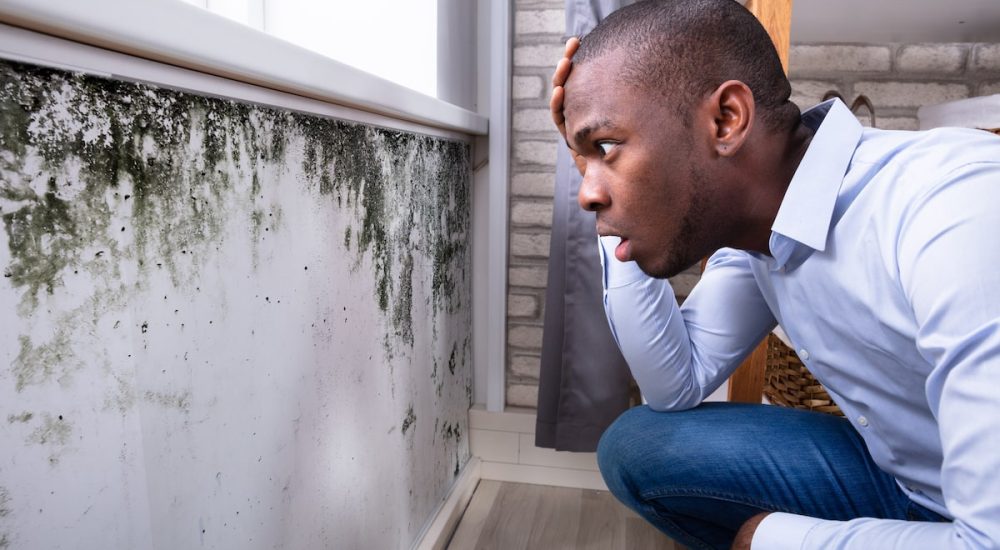
What You Need To Know About Mold In Your Home
Having a home gives one a sense of pride and joy. However, apart from the beauties of home ownership, some challenges come along. One of these challenges includes dealing with mold. At first glance, it might seem insignificant, but the impact of mold on both your property value and health can be far-reaching.
When you search for ‘mold‘ on Google, you will find an alarming amount of information about this seemingly insignificant yet frighteningly pervasive fungus.
Mold is an entity that may appear seemingly harmless but packs a silent but infinitely potent punch. It begins as microscopic spores, floating indoors and outdoors, but when it finds an accommodating area in your home, like your damp basement or humid bathroom, it settles and leaves lasting health effects.
The type of mold that proliferates in your home is highly dependent on the amount of moisture, dampness, and humidity present indoors. Mold growth is often disregarded until it’s too late, and the musty smell has become impossible to ignore. However, the unseen world of mold spores can trigger various health problems, from allergic reactions to asthma attacks and even certain fungal infections.
Mold exposure can be particularly detrimental for those with respiratory issues, leading to symptoms like shortness of breath.
As a keen observer may notice, just as mold can grow, knowledge can, too!
What Is Mold? Understanding The Indoor Fungi
‘Mold‘ isn’t just a single entity– it represents a group of fungi encompassing many species. Ranging from the notorious black mold (Stachybotrys Chartarum) to the less recognized but equally pervasive Alternaria, these different types of mold share the knack for turning your home into their breeding ground.
Mold spores float abundantly throughout various indoor and outdoor environments, searching for amenable conditions to settle and grow.
How Mold Breeds And Grows In An Indoor Environment
Mold growth in an indoor environment isn’t an event; it’s a process. These spores lie dormant, waiting for their ideal ‘housing’ conditions. Give mold spores too little moisture; they remain harmless particles, but present them with a spot that’s too damp, like your basement or bathroom, and you’ll witness a fungal feast.
The recipe includes a touch of humidity and enough organic material for sustenance, giving rise to visible mold growth on your walls, tiles, or drywall.
Mold can grow in your home rather swiftly, with the right constituents; brightness for them equates to dampness, darkness, and stagnant air. This emphasis on growth isn’t to alarm but to help you glean a critical point. By tweaking these indoor conditions to be inhospitable for mold growth, we can prevent mold from settling in the first place — an integral part of safeguarding indoor air quality and the health effects of mold exposure.
Knowledge is not just power; it’s prevention.
Making a Jurassic Difference
Request a reliable, professional inspection and indoor quality test.
Causes Of Mold Growth You Should Know
A. Moisture Sources: Mold growth primarily thrives on moisture within an environment. While mold spores are virtually omnipresent, they only grow when they find a suitable damp surface.
- Leaks are common culprits, as they often go unnoticed, especially if hidden behind walls or under floors. Any leaking pipes, roofs, or even a tiny, constant drip can create an environment conducive to mold growth.
- High Humidity: This can lead to excess moisture and mold. Humidity can come from simple daily activities like bathing, cooking, or drying clothes indoors. These activities can dramatically increase indoor moisture levels without proper ventilation or humidity control.
- Condensation: Cold surfaces can create condensation, as the temperature change turns air moisture into water droplets. These surfaces can then become breeding grounds for mold. It is common on metal pipes, concrete surfaces, tiles, and glass.
B. Poor Ventilation: Nevertheless, even with moisture sources present, proper ventilation can often mitigate mold growth. Without it, a few issues arise:
- Trapping of Moisture: Poorly ventilated homes may trap moisture indoors by not allowing it to escape. It often happens in bathrooms or cooking areas, where steam can’t effectively exit.
- Limiting Airflow: When there’s no air movement, moisture remains on surfaces longer, allowing more time for mold to grow. Poorly ventilated areas often show signs of mold growth before other regions.
- Expediting Mold Growth: Mold spreads via spores. When the ventilation is poor, the concentration of mold spores in the air can increase, promoting faster and more extensive mold growth.
By understanding these factors, homeowners can more readily prevent mold in household environments. Consider having regular checks for leaks, maintaining low humidity levels, and ensuring your home is adequately ventilated.
If these issues are addressed promptly, it forms an effective preventative measure against mold infestations.
Common Types of Mold That Can Infest Your House
A. Aspergillus
Aspergillus is a frequently found mold in households, particularly in warm and highly damp environments. It appears in numerous colors (grey to green, yellow, or white) and resembles a fluffy cover. There are multiple species of Aspergillus with varying health effects.
The health effects of Aspergillus are usually mild, causing allergic reactions. Still, it can pose severe health risks for those with weak or compromised immune systems, causing lung infections and other organs.
B. Penicillium
Penicillium mold varieties are often blue or green and have a strong, musty odor. You will typically find them on materials suffering from water damage, such as wallpapers, carpeting, insulation, and furnishings.
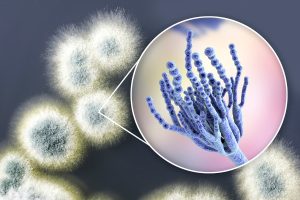
Penicillium mold spores are easily inhaled and can lead to chronic sinus and lung infections. They also cause allergic reactions, including symptoms such as coughing, sneezing, and eye irritation.
C. Stachybotrys Atra (Black Mold)
Commonly referred to as black mold, Stachybotrys Atra is a toxigenic mold that can have severe health impacts. As its nickname implies, it appears black or dark green and often has a slimy texture.
Black mold produces mycotoxins that can lead to health issues such as chronic sinus infections, asthma symptoms, fatigue, depression, and respiratory damage. It’s worth noting that black mold is less common than other types but equally dangerous, hence the importance of immediate remediation.
Knowledge of these common molds, their appearances, and potential health effects play a vital role in quickly identifying and mitigating mold problems in your home.
Identifying A Mold Problem In Your Home
Spotting a mold problem on time can save you from potential health repercussions. Mold can cause symptoms akin to allergies and may intensify asthma symptoms.
Key signs to look out for include:
- A Musty Odor: This is often the first alert of a mold problem in your home.
- Visible Growth: Black mold exposure can be harmful, leading to numerous health issues.
- Water Damage: Moist places are common breeding grounds for mold. It’s essential to survey areas that have encountered water damage.
Remember that mold spores are everywhere, but indoor mold growth typically causes issues. Catching the signs on time can help control mold growth and save you from many health problems.
Locating Mold In Your Home
Attack mold at its root by identifying typical household hotspots. Mold typically lurks in:
- Basements, Bathrooms, And Under Sinks: Places where dampness and mold go hand in hand.
- Less Visible Areas: Such as air ducts and behind walls.
Remember to consider the invasion of mold spores that can enter your home through open entrances. Early detection of mold growing in your home is crucial for preventing potential health problems such as mold allergies and respiratory symptoms from exposure to high mold levels.
Prevention Tips
Prevent mold growth at all costs. Here’s how:
- Control Humidity Levels: High moisture levels in the home can encourage mold growth.
- Repair Leaks Promptly: Dampness and mold love each other.
- Ensure Proper Ventilation: Good air circulation can prevent mold growth.
- Clean Mold Thoroughly: Partial removal can cause mold to regrow. Use soap and water and follow the guide steps to inhibit mold return.
Know that mold is a fungus that can hitch a ride to enter your home through open doors, windows, or clothing. Mold exposure can cause health problems; if left unchecked, mold growing in your home can pose significant health risks. Reduce your exposure by preventing mold growth and keeping mold levels low.
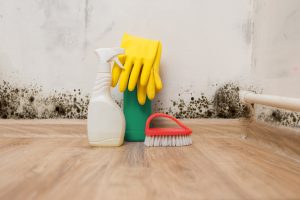
Experiencing mold contamination may require cleaning the mold using soap and water or calling professionals like Jurassic Mold for a mold assessment. But remember, the key to preventing mold and mold spores from increasing is creating an indoor environment less conducive to mold growth.
Health Effects Of Mold Exposure
Breathing in mold spores can lead to a multitude of health problems. Mold allergies are common and can cause sneezing, itchy eyes, and skin rashes. Mold can also intensify asthma symptoms for those suffering from the condition. Exposure to high levels of mold, particularly black mold exposure, can trigger severe respiratory issues.
High-risk individuals, such as older people, infants, or those with weak immune systems, are susceptible to mold. So, managing a mold problem is essential to minimize these health effects.
Potential Dangers Of Long-Term Mold Exposure
When mold grows unchecked in your home, you are exposed to mold over a prolonged period. This long-term exposure can lead to chronic health conditions. Mold can cause headaches, persistent cough, and fatigue. It can also affect mental health, causing mood swings and memory loss. Over time, black mold exposure can even lead to severe respiratory diseases.
Take heed: If mold is present in your home, it’s not just a cosmetic or property damage concern but a severe health risk, which is why controlling mold growth and reducing exposure is essential.
Mold and health are intricately linked. To protect yourself, your health, and well-being, prioritize preventing mold growth. Keep your indoor environment dry and clean. If you see mold, clean up the mold as soon as possible to avoid further negative consequences from mold exposure.
Mold And Health: Long-Term Consequences
Persistent mold exposure is more dangerous to your health than a mere allergic reaction. It’s crucial to understand the variety of chronic health conditions that stem from exposure to this aggravating fungus:
- Asthma: Mold spores can worsen existing asthma symptoms or trigger the development of new cases.
- Sinusitis: Consistent inhalation of mold spores can cause ongoing inflammation of the sinuses, leading to chronic sinusitis.
- Bronchitis: Extended exposure to mold can cause chronic bronchitis, affecting your lungs and respiratory health.
- Fungal Infections: Prolonged mold exposure may result in lung or skin fungal infections.
- Weakened Immune System: The constant presence of mold spores can cut your immune system, making you more susceptible to other illnesses.
To prevent these severe long-term consequences, prioritize controlling indoor humidity, keeping damp areas like basements and bathrooms clean and dry, and improving indoor air quality.

Addressing The Psychological Effects Of Mold
Mold growth can also take a toll on mental wellness:
- Sleep Disturbances: Mold exposure can disrupt sleep patterns due to respiratory issues and allergies.
- Anxiety & Depression: Living with ongoing mold problems can create anxiety, stress, and even depression as health and living conditions worsen.
- Cognitive Issues: Mold can harm cognitive function, causing forgetfulness or difficulty concentrating over time.
You can protect your well-being across multiple facets by addressing mold and dampness in your home and keeping it well-ventilated. Stay proactive when it comes to maintaining a mold-free environment, both indoors and outdoors.
Mold Growth: Why It Thrives In Your Home
Moisture is the critical factor that allows mold to grow in your home. From water leaks to high humidity levels, mold spores thrive in damp conditions. Areas of the house particularly prone to mold growth include the basement, bathroom, and kitchen, where water usage is high. Poor ventilation can also encourage mold growth, preventing moisture from drying and providing the perfect environment for mold.
Control mold growth by maintaining a dry indoor environment, fixing leaks promptly, and ensuring your home has good ventilation. You must also immediately clean and dry damp areas – mold can grow within 24 to 48 hours.
Exploring A ‘mold-Friendly’ Environment
A mold-friendly environment extends beyond just dampness. Other conditions that encourage mold growth include darkness, warmth, stagnant air, and organic material (like wood, paper, fiber, or dirt).
It helps to comprehend that mold is a type of fungus. It’s not ‘evil’ – it merely performs an essential role in nature by breaking down dead organic material. Unfortunately, that ability to break things down can cause substantial damage when mold grows indoors.
Therefore, ensure your home is not inviting to keep mold at bay. Limit the elements it needs—moisture, darkness, warmth, stagnant air—by regularly airing and cleaning your home, keeping it well-lit and calm, and reducing moisture zones. Checking your home for mold is a proactive step towards a healthier, mold-free environment.
No pressure, No hassles
We’re licensed, insured, certified, and 100% focused on mold and air quality
Dealing With A Mold Infestation: What To Do If Mold Is Growing In Your Home
Finding mold growing in your home can be alarming, but acting can prevent further damage. Follow these steps when you’ve discovered a mold problem:
- Assess The Extent: Examine the size of the mold growth and whether it’s widespread or localized.
- Determine The Root Cause: Address the underlying cause, like water leaks or dampness.
- Use Proper Cleaning Methods: If dealing with a small area, use soap and water to clean up the mold.
- Dispose Of Contaminated Items: If mold-infested materials cannot be salvaged, discard them responsibly.
- Dry Affected Areas: Properly drying spaces can help prevent mold from growing back.
- Monitor Progress: Regularly check the treated areas to ensure mold isn’t returning.
When To Seek Professional Help For Mold Remediation
If you suspect your mold problem is extensive or you’re dealing with toxic black mold, it may be necessary to seek professional help. Other scenarios where professional remediation is recommended include:
- Recurring Mold Growth: If mold keeps returning after multiple attempts at removal.
- Health Concerns: If someone in your home is sensitive to mold, has asthma, or exhibits mold allergy symptoms.
- Extensive Damage: If your home has experienced significant water damage or has large areas of mold growth.
- Unknown Origin: If you cannot locate the mold problem’s source, a professional mold assessment can help identify hidden growth.
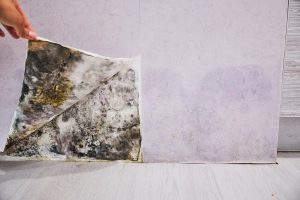
How to Maintain a Mold-Free Indoor Environment
Bathrooms, basements, and kitchens are hotspots for dampness and humidity, the perfect breeding ground for this type of mold. Prevent mold by ensuring these areas are well-ventilated and dry. Air conditioners can help maintain indoor air quality, reducing dampness.
Check the water around the drywall, possibly in a leaky basement where mold can grow. Be proactive to avoid fungal infection or shortness of breath from mold exposure!
Protecting Vulnerable Populations From Mold Exposure
Certain molds have the potential to cause severe allergic reactions. Vulnerable populations such as children, elderly people, and individuals with compromised immunity must be shielded from mold exposure.
Setting proper cleanliness protocols and maintaining a dry, well-ventilated indoor environment safeguards all indoors and outdoors from the ill effects of mold. A keen eye on frequently damp areas and reduction of indoor humidity minimizes mold growth, protecting everyone within your four walls.
Remember, mindful indoor environment management is critical to preventing mold growth in your home. Take necessary steps, deprive mold of its lifeline – dampness, and steer clear of associated health effects. Your home should be your sanctuary, not a breeding ground for harmful mold spores!
Proactive Measures To Prevent Mold Growth In Your Home
Control mold growth by tackling dampness. Remember, prevent mold growth by ensuring proper ventilation in critical home areas, like the bathroom or the kitchen.
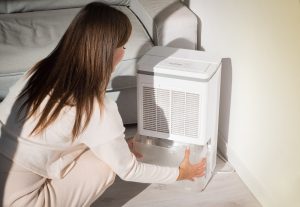
Invest in a good dehumidifier, especially in a high-humid area. Ensure you maintain an optimum indoor environment, as too humid or cold can encourage mold growth.
Remember that mold spores cause allergic reactions in those sensitive to mold. Always immediately clean up the mold with soap and water if mold grows in your home. Prevention is always better than cure.
Importance Of Regular Home Maintenance To Keep Mold At Bay
Regular home maintenance helps control mold growth. Be sure your home is always dry. Fix leaks promptly and avoid standing water in any part of your house.
High levels of household mold can cause acute idiopathic respiratory symptoms, especially in those exposed to mold. Black mold exposure can trigger asthma symptoms in people with asthma.
Seal your home! Remember, mold spores are everywhere and can enter your home through open windows or doors. Prevent mold from growing in your home by sealing cracks and openings.
Hiring professional help for a mold assessment may be necessary, especially if you suspect a mold problem.
Remember, there’s no room for complacency when protecting your home and health from the effects of mold. Implement these steps regularly to prevent future occurrences of this pervasive, pesky fungus.
The Mold Removal Process with Jurassic Mold
When you contact Jurassic Mold, you’re taking the first step toward a mold-free home. Here’s what you can expect:
- Assessment: Our experts will conduct a thorough inspection of your property to identify the extent of the mold problem and its causes.
- Customized Plan: Based on our assessment, we’ll develop a personalized mold removal plan that outlines the steps needed to eliminate the issue completely.
- Safe Removal: Our team will use the latest technology and industry best practices to remove mold safely and efficiently.
- Prevention: Once the mold is removed, we’ll advise you on preventive measures to ensure it doesn’t return.
Don’t let mold compromise the safety and comfort of your home any longer. Take the first step toward a mold-free future by contacting Jurassic Mold. Our friendly and knowledgeable team is ready to answer your questions and schedule a consultation at your convenience.
Experience the difference that professional mold removal can make in your life. Contact Jurassic Mold today and say goodbye to mold for good!
